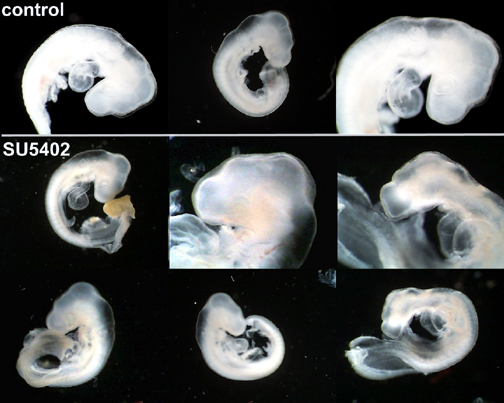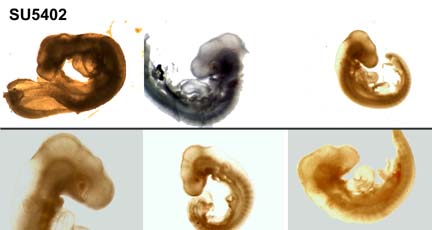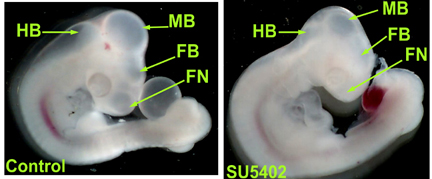|
|
|
RESULTS
FGF signaling is crucial to proper embryonic development. To
determine how interfering with FGF signaling affects 2 day
embryos we treated embryos with SU5402, a FGFR inhibitor.
The survival ratio for control and experimental embryos was
87% (n=16) and 58% (n=24), respectively, when incubated for
1 day after injection. Interestingly, the experimental
embryos exhibited normal limb bud development. However, the
craniofacial region of some of the treated embryos were
malformed in that they exhibited an abnormal head to body
ratio(head being smaller than normal). The most prominent
defects were reduced size forebrain, midbrain, and
frontal-nasal process (Figure 1). We also observed abnormal
blood pools, indicative of poor vascularizaation. The
control embryos were developing normally and had no
noticeable malformations, when they were observed and
photographed (Figure 1).

(a)

(b)
Figure 1. SU5402 treatment. Experimental embryos
display delayed development
and craniofacial defects. (a) Darkfield images: control-
first row, SU5402 - bottom two rows; (b) Digital images:
SU5402 - top row, control - bottom row
Embryos incubated for 2 days
after SU5402 injection showed a 16% (n=12)survival rate.
Surviving experimental embryos displayed severe cases of the
craniofacial deformities mentioned above as well as
extensive blood pooling at the posterior end of the embryos
(Figure 2). The survival rate for the control embryos was
86% (n=6). Since SHH and FGF are known to be involved in
regulatory feedback loops in the the limb, lung, feather bud
and other systems we processed embryos with shh
riboprobe to determine the effect of interfering with
FGF signaling on levels of shh

Figure 2. Comparison of control and SU5402
treated embryos. SU5402 results in
decreased hindbrain (HB), midbrain (MB), forebrain (FB), and
frontal nasal (FN) processes.
|
|